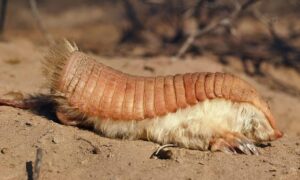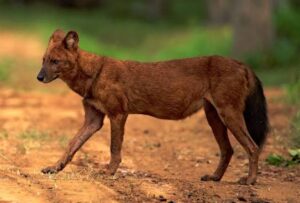Gerenuk: The Long-Necked Antelope of the African Plains
Introduction
Among the countless species that wander Africa’s arid landscapes, few capture attention quite like the gerenuk (Litocranius walleri). At first glance, it seems almost otherworldly: an antelope with impossibly long legs, a slender body, and most striking of all—a neck so elongated it gives the animal a giraffe-like elegance. Its name itself reflects this uniqueness. “Gerenuk” comes from the Somali word garanuug, meaning “giraffe-necked.”
Unlike most antelopes that graze or browse close to the ground, the gerenuk has mastered an unusual feeding strategy. It is one of the only antelopes that can stand upright on its hind legs, stretching its body to reach foliage well beyond the reach of competitors. This adaptation makes it a specialist in browsing shrubs and small trees in some of the driest ecosystems of East Africa.
Despite its beauty and evolutionary uniqueness, the gerenuk remains one of Africa’s lesser-known antelopes, often overshadowed by its charismatic cousins such as gazelles, impalas, or kudu. Yet its biology, behavior, and survival strategies are remarkable and worthy of deeper exploration.
This article will take you on an in-depth journey into the world of the gerenuk—its anatomy, feeding adaptations, social structures, cultural significance, and the conservation challenges it faces today.
The Name and Taxonomy
The gerenuk is scientifically known as Litocranius walleri. Its taxonomy places it in the family Bovidae, the same family as cattle, goats, and other antelopes.
- Genus: Litocranius
- Species: Litocranius walleri
- Authority: First described by naturalist E. Brooke in 1878.
The genus name Litocranius comes from Greek roots meaning “stone skull,” while the species name walleri honors Sir Gerald Waller, a 19th-century explorer in East Africa.
The Somali name garanuug—meaning “giraffe-necked”—aptly captures the creature’s most notable feature. In Swahili, it is sometimes referred to as “swala twiga,” or “giraffe gazelle.”
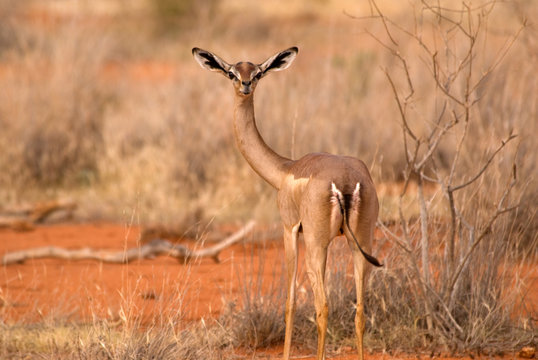
Physical Characteristics
The gerenuk’s appearance sets it apart immediately from other antelopes.
Size and Build
- Height: Shoulder height is about 80–105 cm (31–41 inches).
- Weight: Males weigh 30–52 kg (66–115 lbs); females are lighter, 28–45 kg (62–99 lbs).
- Neck: Long and thin, resembling a miniature giraffe’s.
- Legs: Slender and elongated, built for both speed and upright posture.
- Body: Narrow and graceful, with a short tail tipped in black.
Coat and Coloring
- Dorsal Side: Reddish-brown or chestnut.
- Flanks: Lighter tan.
- Underparts: Whitish.
- Markings: Distinct white patches around eyes and mouth, with darker facial stripes.
This coloration provides excellent camouflage in semi-arid scrublands where shadows and shrubs dominate the landscape.
Horns
Only males possess horns.
- Shape: Curved, lyre-shaped.
- Length: 25–44 cm (10–17 inches).
- Texture: Heavily ridged at the base, smooth toward the tips.
Females lack horns, which helps distinguish the sexes in the field.
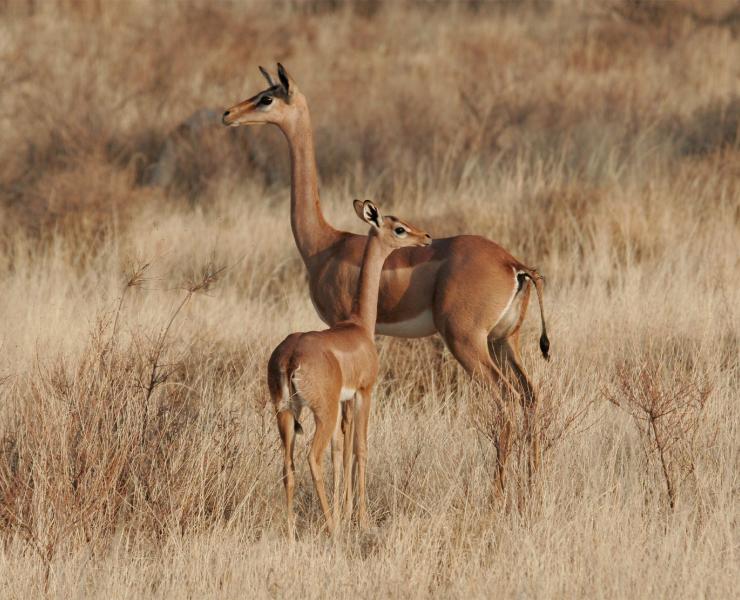
Adaptations for Survival
The gerenuk thrives in environments where many other antelopes would struggle.
Standing to Browse
Its most extraordinary adaptation is the ability to stand upright on hind legs.
- By balancing on its hind legs and stretching its neck, the gerenuk can browse up to 2 meters (6.5 feet) off the ground.
- This allows access to young shoots, buds, and tender leaves that are unavailable to other antelopes.
Diet Without Water
The gerenuk rarely drinks water.
- Instead, it derives most of its moisture from leaves, flowers, and fruits.
- This adaptation allows it to survive in arid habitats where permanent water sources are scarce.
Narrow Muzzle and Mobile Lips
Its small, pointed snout and flexible lips allow the gerenuk to carefully select the most nutritious plant parts, avoiding thorns and tough fibers.
Habitat and Range
The gerenuk inhabits dry bushlands, thornbush savannas, and semi-desert regions of East Africa.
Distribution
- Countries: Kenya, Tanzania, Ethiopia, Somalia.
- Smaller populations exist in Eritrea and parts of northern Uganda.
Preferred Habitat
- Vegetation: Open woodlands, acacia scrub, thorny shrubs.
- Climate: Semi-arid to arid zones with low rainfall.
- Avoids: Dense forests and open grasslands.
This niche—intermediate between gazelle habitats (open plains) and kudu habitats (wooded areas)—gives the gerenuk a competitive advantage in its unique ecological role.
Feeding Ecology
The gerenuk’s feeding behavior is central to its survival strategy.
Diet Composition
- Leaves from acacia and commiphora shrubs.
- Shoots and buds of woody plants.
- Fruits and flowers, especially when in season.
Foraging Technique
- The gerenuk rises onto its hind legs.
- It balances by pressing forelegs against a branch.
- Its long neck and slender muzzle stretch to pluck tender leaves.
This behavior is unique among antelopes and resembles giraffes’ browsing—hence its nickname, the “giraffe gazelle.”
Competition Avoidance
By specializing in higher browsing, the gerenuk avoids direct competition with gazelles (which graze lower) and larger antelopes like kudu (which browse higher).
Social Structure and Behavior
Grouping
- Gerenuks are generally solitary or found in small groups.
- Females form small herds with their offspring.
- Males are territorial and often solitary.
Territorial Behavior
- Males mark territories with glandular secretions and dung piles.
- Territories may range from 2–6 square kilometers.
Activity Patterns
- Diurnal: Active mainly in the early morning and late afternoon.
- Rest in shaded cover during the hottest hours.
- Nocturnal activity is rare.
Reproduction and Life Cycle
Courtship
- Males use a behavior called “tapping”, where they nudge the female’s hindquarters with their forelegs to test receptivity.
- If receptive, mating occurs quickly.
Breeding Season
- Gerenuks breed year-round, though peaks may occur after rainy seasons when food is abundant.
Gestation and Birth
- Gestation period: ~7 months.
- Offspring: Usually a single calf.
- Calves are hidden in tall grass or shrubs for several weeks before joining the mother.
Lifespan
- Wild: 8–12 years.
- Captivity: Up to 15 years.
Predators and Threats
Natural Predators
- Lions.
- Leopards.
- Cheetahs.
- African wild dogs.
- Hyenas.
Calves are especially vulnerable to jackals and eagles.
Anti-Predator Strategies
- Camouflage: Their reddish-brown coats blend with arid landscapes.
- Vigilance: Large eyes and ears detect predators early.
- Speed: Can run swiftly in zigzag patterns to evade predators.
Evolutionary Significance
The gerenuk represents a fascinating case of convergent evolution. Its browsing adaptation mirrors that of giraffes, though the two are only distantly related.
Paleontological evidence suggests that African antelopes diversified to exploit different feeding niches—some grazers, some browsers. The gerenuk specialized in mid-level browsing, carving out a niche with little competition.
Cultural Significance
While not as prominent in folklore as larger African mammals, the gerenuk has cultural and symbolic roles:
- Somali communities recognize it for its “giraffe-like” appearance.
- In local storytelling, its unusual posture while feeding often inspires metaphors of balance, reaching high, or striving beyond limitations.
In modern times, the gerenuk is occasionally featured in wildlife documentaries, highlighting Africa’s lesser-known species.
Conservation Status
The International Union for Conservation of Nature (IUCN) currently lists the gerenuk as Near Threatened.
Population
- Estimated 95,000–100,000 individuals remain in the wild.
- Populations are fragmented across East Africa.
Threats
- Habitat loss from agriculture and overgrazing by livestock.
- Hunting for meat and skins.
- Predation pressure in areas with declining habitat cover.
Conservation Efforts
- Protected areas such as Tsavo (Kenya) and Serengeti (Tanzania) harbor stable populations.
- Community-based conservation programs aim to reduce poaching.
Gerenuk in Captivity
Gerenuks are occasionally kept in zoos. They require:
- Spacious enclosures with climbing vegetation.
- Specialized diets (browsing plants, alfalfa, acacia).
Their unique feeding style and striking appearance make them educational ambassadors for African biodiversity.
Fascinating Facts
- The gerenuk is one of the only antelopes that rarely drinks water.
- It can stand upright for minutes at a time without support.
- Its gestation period (7 months) is longer than that of many other small antelopes.
- Unlike many antelopes, males and females look quite different (sexual dimorphism in horns and size).
- Its scientific name Litocranius walleri literally means “stone skull of Waller.”
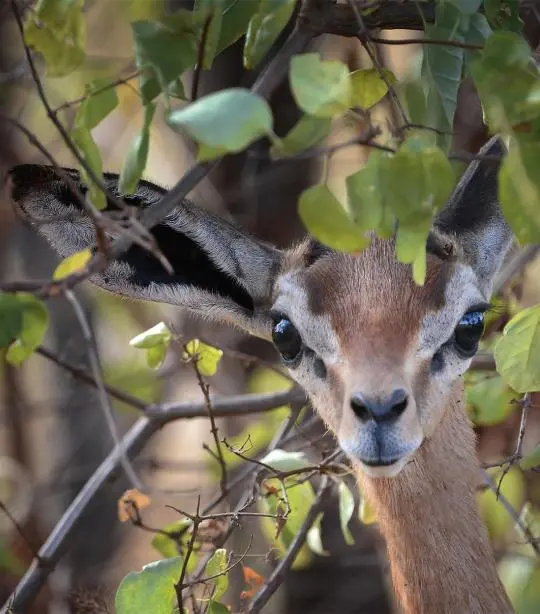
Table: Gerenuk at a Glance
| Feature | Description |
|---|---|
| Scientific Name | Litocranius walleri |
| Common Name | Gerenuk, giraffe gazelle |
| Family | Bovidae |
| Weight | Males: 30–52 kg; Females: 28–45 kg |
| Height | 80–105 cm at shoulder |
| Range | Kenya, Tanzania, Ethiopia, Somalia |
| Habitat | Dry bushland, thorn scrub, semi-desert |
| Diet | Leaves, buds, flowers, fruits |
| Unique Trait | Stands upright to browse vegetation |
| Gestation Period | 7 months |
| Lifespan | 8–12 years (wild), 15 years (captivity) |
| Conservation Status | Near Threatened (IUCN) |
Final Thoughts
The gerenuk may not have the size of an elephant, the power of a lion, or the fame of a giraffe, but in its quiet way, it is one of Africa’s most remarkable evolutionary experiments. By developing a long neck and the ability to stand upright, it carved out a feeding niche few others could exploit.
In the harsh, dry scrublands of East Africa, this adaptation is the difference between survival and starvation. The gerenuk’s very existence reminds us of the diversity and creativity of evolution. It also reminds us of fragility—because even the most specialized species can be undone by human pressures.
Protecting the gerenuk means protecting the unique ecosystems it inhabits—ecosystems where every species, from thorny acacia to prowling cheetah, plays a vital role. The sight of a gerenuk balanced gracefully on its hind legs, stretching for leaves beneath the African sun, is one of nature’s quiet wonders—a moment that speaks of resilience, adaptation, and beauty in survival.

